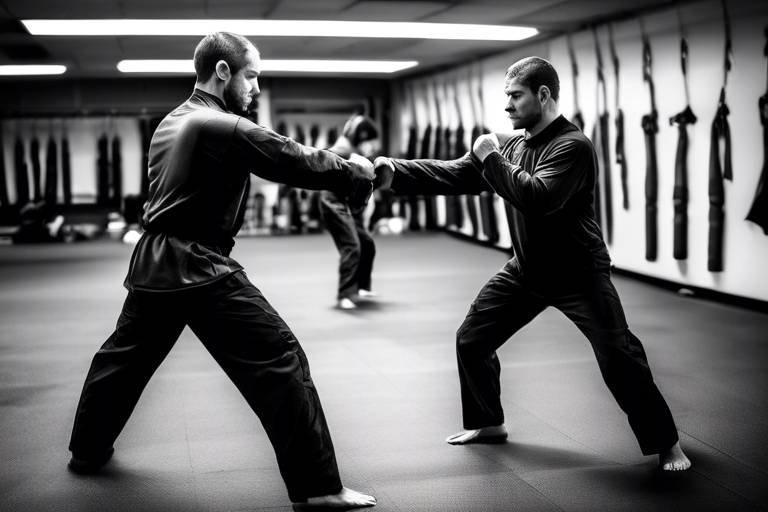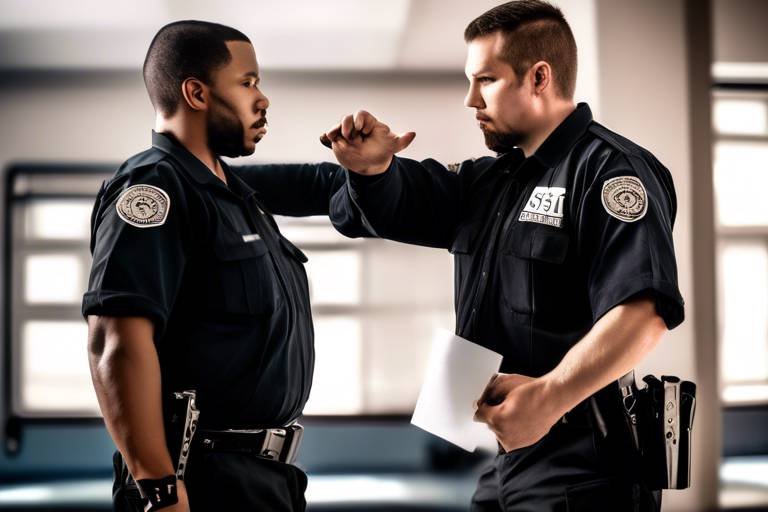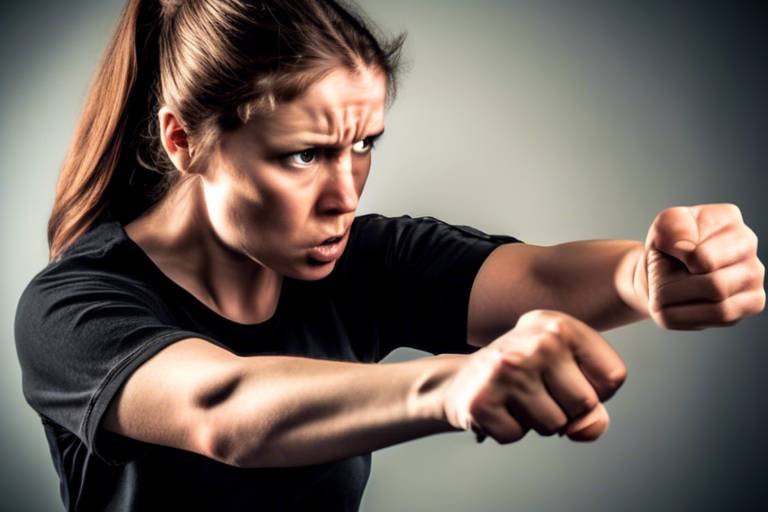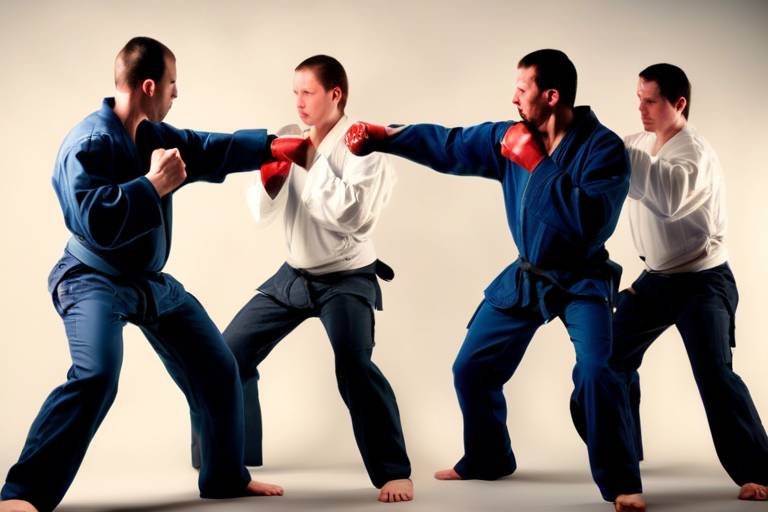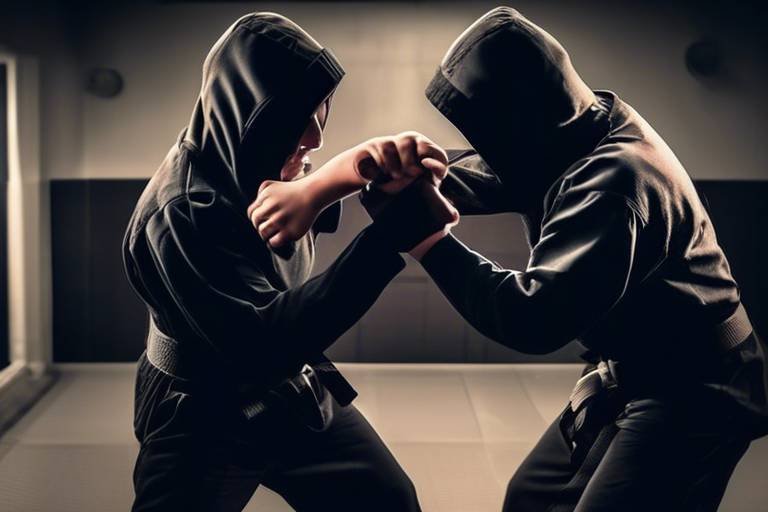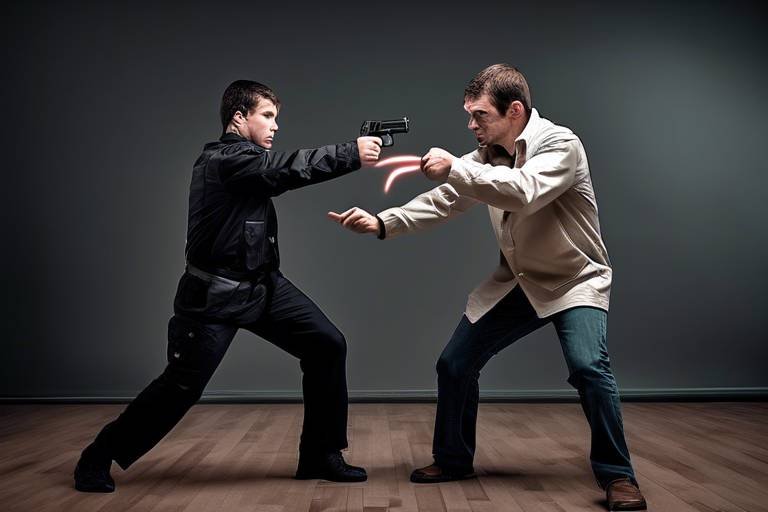A Guide to Self-Defense Training: What You Need to Begin
Self-defense is not just about throwing punches or executing fancy kicks; it's a holistic approach to personal safety that combines physical techniques with mental preparedness. Whether you're a complete beginner or someone looking to refine your skills, embarking on a self-defense journey can be both empowering and transformative. The essence of self-defense training lies in understanding your surroundings, recognizing potential threats, and responding effectively when necessary. This article will guide you through the essentials of self-defense training, including techniques, mental preparation, equipment, and resources to help you confidently start your journey.
So, what exactly is self-defense? It's a collection of techniques and strategies aimed at protecting oneself from harm. Think of it as your personal armor against the unpredictable nature of the world. The principles of self-defense are rooted in awareness, avoidance, and action. Awareness involves being conscious of your environment and recognizing potential threats before they escalate. Avoidance is about steering clear of dangerous situations whenever possible. Finally, action is the physical response you take when faced with a threat. Understanding these principles is crucial for effective training and application in real-life situations.
With a multitude of self-defense styles available, how do you pick the right one for you? Different styles cater to various needs and preferences, so it's essential to explore your options. Popular styles like Krav Maga, Brazilian Jiu-Jitsu, and Karate each offer unique benefits. For instance, Krav Maga focuses on real-world scenarios and practical techniques, while Brazilian Jiu-Jitsu emphasizes ground fighting and submissions. Karate, on the other hand, teaches striking techniques and discipline. By exploring these styles, you can find the perfect fit for your training goals.
When selecting a self-defense style, several factors come into play. These include:
- Physical Abilities: Your current fitness level can influence which self-defense style will be most effective and enjoyable for you. Tailoring your training to your capabilities is essential for success.
- Training Environment: Consider where you will be training. Some styles may require more space or specific equipment.
- Personal Safety Concerns: Assessing your specific safety concerns, such as urban versus rural environments, can help you choose a self-defense style that addresses your unique vulnerabilities.
Your physical fitness level plays a significant role in determining the right self-defense style for you. If you're starting from scratch, you might want to choose a style that gradually builds your strength and endurance. On the other hand, if you're already physically active, you may be ready to dive into more intense training. Remember, self-defense should be a journey, not a sprint!
Understanding your personal safety needs is crucial in selecting the right self-defense style. For example, if you live in an urban area, you might prioritize techniques that help you escape from tight situations or deal with multiple attackers. Conversely, those in rural settings may want to focus on self-defense against wildlife or larger threats. Tailoring your training to your environment can make all the difference in your preparedness.
Familiarizing yourself with common self-defense techniques can significantly enhance your training. Techniques like striking, grappling, and escape maneuvers are vital components of effective self-defense. Here’s a quick breakdown:
- Striking: This includes punches, kicks, and elbow strikes aimed at incapacitating an attacker.
- Grappling: Techniques that involve holds and locks to control or subdue an opponent.
- Escape Maneuvers: Skills that help you break free from grabs or holds and create distance from a threat.
Having the right equipment can enhance your self-defense training experience. Basic gear includes training mats, protective gear, and appropriate clothing to ensure safety and comfort. Investing in quality equipment not only boosts your confidence but also minimizes the risk of injury during practice.
Investing in quality protective gear, such as gloves and mouthguards, is crucial for safe practice. This equipment helps prevent injuries during training sessions, allowing you to focus on honing your skills without the fear of getting hurt. Remember, safety first!
Incorporating training tools like punching bags and focus mitts can improve your technique and build strength. These tools enhance your overall self-defense skills and preparedness. Just like a musician practices with instruments, you must train with the right tools to master your self-defense techniques.
1. How long does it take to learn self-defense?
The duration varies based on the style and your commitment. Some people may feel comfortable with basic techniques in a few months, while mastering them can take years.
2. Do I need to be fit to start self-defense training?
No, self-defense training is for everyone, regardless of fitness level. Many classes accommodate beginners and gradually build strength and skills.
3. Is self-defense training expensive?
Costs can vary widely depending on the school, location, and equipment needed. However, many community centers offer affordable classes.
4. Can self-defense training help with confidence?
Absolutely! Many practitioners report increased confidence and awareness after training, which can translate to other areas of life.

Understanding Self-Defense
Self-defense is not just about throwing punches or executing fancy kicks; it's a comprehensive approach to ensuring your safety in potentially dangerous situations. At its core, self-defense encompasses a variety of techniques and strategies designed to protect oneself from harm. Think of it as a mental and physical toolkit that equips you to respond effectively when faced with a threat. Understanding the principles of self-defense is crucial, as it not only prepares you for physical encounters but also empowers you to make informed decisions in high-pressure situations.
Self-defense training goes beyond the physical aspect; it also involves developing a strong mental framework. Imagine yourself in a scenario where you need to react quickly. Your ability to stay calm, assess the situation, and make strategic decisions can be the difference between safety and danger. This mental preparation is just as vital as mastering the techniques. Therefore, when you embark on your self-defense journey, it's important to focus on both the physical skills and the mindset needed to apply them effectively.
Moreover, self-defense is not a one-size-fits-all concept. The techniques you choose to learn should resonate with your personal style and comfort level. For instance, some people might feel more empowered by learning striking techniques, while others may prefer grappling or escape maneuvers. The beauty of self-defense lies in its versatility; it can be tailored to fit your specific needs and preferences. To illustrate this, let’s break down some fundamental principles of self-defense:
- Awareness: The first line of defense is being aware of your surroundings. This means paying attention to the people and situations around you, which can help you avoid potential threats.
- De-escalation: Often, the best self-defense is avoiding confrontation altogether. Learning how to communicate effectively and diffuse tense situations can keep you safe without physical confrontation.
- Physical Techniques: While not all encounters will require physical action, knowing how to defend yourself with effective techniques is essential. This includes knowing how to strike, escape holds, and utilize leverage.
- Legal Knowledge: Understanding the laws surrounding self-defense in your area is crucial. What may be considered self-defense in one state could be viewed differently in another.
In summary, self-defense is a multifaceted discipline that combines mental preparedness, physical techniques, and situational awareness. As you delve deeper into this journey, remember that the goal is not just to become a fighter but to cultivate a sense of confidence and security in your daily life. With the right mindset and training, you can transform yourself into not just a defender but a proactive guardian of your own safety.

Choosing the Right Self-Defense Style
When it comes to self-defense, choosing the right style is like picking the perfect outfit for a big event. You want something that fits you just right, feels comfortable, and serves its purpose effectively. With so many options available, it can be overwhelming to decide which self-defense style aligns with your personal goals, physical abilities, and safety concerns. So, let’s break it down and explore some of the most popular styles, along with what you should consider when making your choice.
First off, let’s consider the variety of self-defense styles out there. Each style has its unique flavor, philosophy, and techniques. For instance, Krav Maga is known for its focus on real-world situations and practical techniques, making it ideal for those who want to prepare for unexpected encounters. On the other hand, Brazilian Jiu-Jitsu emphasizes ground fighting and grappling, which can be particularly effective if you find yourself in a close-range confrontation. Karate, with its striking techniques and discipline, offers a different approach that combines physical fitness with mental focus.
Now, you might be thinking, “How do I choose among these?” Here are a few factors to consider:
- Your Physical Abilities: Are you agile and flexible, or do you prefer a style that focuses on strength? Knowing your physical strengths will help you pick a style that plays to them.
- Your Training Environment: Do you have access to a dojo, gym, or outdoor space? Some styles require specific settings for effective training.
- Your Personal Safety Concerns: Are you more concerned about street safety, or do you want to learn self-defense for sport? Your environment and lifestyle will heavily influence your choice.
Let’s dive a little deeper into these factors:
Your current fitness level can significantly impact your training experience. If you’re just starting out or haven’t been active for a while, you might want to consider styles that don’t require advanced physical conditioning right away. For example, styles like Aikido focus on using an opponent's energy against them, making it accessible for individuals of varying fitness levels. Conversely, if you’re already in good shape and looking for a challenge, styles like Muay Thai or Kickboxing might be right up your alley, as they demand higher levels of stamina and strength.
Understanding your specific safety concerns is crucial. For instance, if you live in an urban area where the likelihood of encountering aggressive individuals is higher, a style like Krav Maga that emphasizes quick, effective techniques might be more beneficial. Alternatively, if you’re in a rural setting where confrontations are less common, you might prefer a style that focuses on self-discipline and fitness, like Tai Chi or Karate. It’s all about tailoring your training to your lifestyle.
In summary, choosing the right self-defense style is a personal journey that requires thoughtful consideration of your physical abilities, training environment, and safety needs. Take the time to explore various options, attend a few trial classes, and listen to your instincts. Remember, the best self-defense style is one that you feel comfortable with and excited to practice. So, gear up and get ready to find your perfect match!
Q: How do I know which self-defense style is best for me?
A: Consider your physical fitness, personal safety concerns, and what you hope to achieve through training. Trying out different classes can also help you decide.
Q: Is self-defense training suitable for everyone?
A: Absolutely! Self-defense training can be adapted for all ages and fitness levels, making it accessible to everyone.
Q: How long does it take to become proficient in a self-defense style?
A: Proficiency varies by individual and style, but consistent practice over several months can lead to significant improvement.

Factors to Consider
When embarking on your self-defense training journey, there are several key factors you should take into account to ensure you choose the right path for your needs. Think of it like selecting the perfect pair of shoes; you wouldn’t just pick the first pair you see without considering how they fit, how comfortable they are, and whether they suit your lifestyle. Similarly, understanding the factors influencing your self-defense training can make a significant difference in your effectiveness and enjoyment.
First and foremost, your physical fitness level plays a pivotal role. Self-defense styles vary widely in their physical demands. For example, if you're just starting out or if you haven’t been active for a while, it might be wise to consider styles that focus more on technique and less on brute strength. On the other hand, if you're already physically fit and enjoy high-intensity workouts, you might thrive in a more demanding style like Krav Maga or Muay Thai. It’s essential to tailor your training to your current capabilities to avoid injury and frustration.
Next, think about your personal safety needs. The environment you live in can greatly influence your training choice. For instance, if you reside in a bustling urban area, you might want to focus on techniques that help you escape or evade potential threats. In contrast, if you live in a quieter, rural setting, your training might emphasize awareness and de-escalation techniques. Understanding the specific risks you may encounter can help you select a self-defense style that addresses your unique vulnerabilities.
Another factor worth considering is the training environment. Some self-defense classes are held in formal settings like gyms or studios, while others might take place outdoors or in community centers. The atmosphere can affect your comfort level and willingness to engage fully in the training. Additionally, consider the availability of classes in your area. It’s important to find a reputable instructor and a class that fits your schedule, as consistency is key to mastering any self-defense technique.
Lastly, think about your goals for self-defense training. Are you looking to gain confidence, improve your fitness, or learn how to protect yourself in a dangerous situation? Defining your objectives can help narrow down your choices and ensure that the training you pursue aligns with what you hope to achieve. Remember, self-defense is not just about physical techniques; it’s also about building mental resilience and awareness.
In summary, when choosing a self-defense style, consider your physical fitness level, personal safety needs, training environment, and goals. By taking these factors into account, you'll be better equipped to select a training program that not only meets your needs but also empowers you to feel secure and confident in your ability to protect yourself.
- What is the best self-defense style for beginners? It often depends on personal preference, but styles like Brazilian Jiu-Jitsu and Karate are popular choices for those just starting out.
- How often should I train? Consistency is key! Aim for at least 2-3 times a week to see significant improvements.
- Do I need special equipment to start training? While some classes may provide gear, it's advisable to invest in basic protective equipment like gloves and a mouthguard.
- Can self-defense training help with confidence? Absolutely! Training not only teaches you techniques but also boosts your self-esteem and situational awareness.

Physical Fitness Level
Your plays a significant role in determining which self-defense style is best suited for you. Think of it like choosing a pair of shoes; you want something that fits well and feels comfortable, right? The same principle applies here. If you're just starting your fitness journey, you might find certain styles, like Brazilian Jiu-Jitsu, more accessible because they often focus on technique and leverage rather than brute strength. On the other hand, if you're already a fitness enthusiast, you might thrive in a more intense environment like Krav Maga, which emphasizes quick, powerful movements and real-world scenarios.
It’s essential to assess your current fitness level honestly. Are you a couch potato or a gym rat? This self-awareness will guide your training choices. For instance, if you have limited strength or endurance, you might want to start with a style that emphasizes technique over power. As you progress, you can gradually incorporate more physically demanding styles into your regimen. This approach not only helps in building confidence but also ensures that you don't get overwhelmed or discouraged.
Moreover, consider the following aspects of your physical fitness:
- Cardiovascular Endurance: A good cardiovascular base will help you handle the physical demands of self-defense training. Styles that require high energy output, like kickboxing, may be more challenging if your endurance is low.
- Strength: While many self-defense techniques rely on technique rather than strength, having a baseline level of strength can make a significant difference, especially in grappling arts.
- Flexibility: Flexibility can enhance your ability to perform various techniques. Regular stretching and flexibility training can help you become more agile and responsive.
In conclusion, understanding your physical fitness level is not just about picking a style; it's about setting yourself up for success. By choosing a self-defense training program that aligns with your current capabilities, you can ensure that your journey is both enjoyable and rewarding. Remember, self-defense is not solely about fighting; it’s about empowering yourself and gaining confidence in your abilities. So, lace up those shoes and get ready to kick-start your self-defense journey!
1. Do I need to be fit to start self-defense training?
No, you don't need to be fit to start self-defense training. Many programs cater to all fitness levels, and you can gradually improve your fitness as you train.
2. How long does it take to become proficient in self-defense?
The time it takes to become proficient varies based on the individual, the training frequency, and the complexity of the techniques. Generally, consistent practice over several months will yield noticeable improvements.
3. Can self-defense training help with fitness?
Absolutely! Self-defense training can significantly improve your fitness levels, including strength, endurance, and flexibility, while also teaching you valuable skills.
4. Is self-defense training suitable for all ages?
Yes, self-defense training can be adapted for all ages. Many programs offer classes specifically designed for children, teens, and seniors, focusing on safety and confidence.

Personal Safety Needs
When it comes to self-defense, understanding your is paramount. It's not just about learning how to throw a punch or escape a hold; it's about tailoring your training to fit your unique circumstances. For instance, if you live in a bustling city, your self-defense strategies may differ significantly from those of someone residing in a quiet rural area. Urban environments often present different threats, such as muggings or assaults in crowded places, while rural areas might have fewer incidents but could involve different types of confrontations.
Moreover, consider the demographics of your surroundings. Are you frequently in environments where you might be outnumbered? Or perhaps you often find yourself in situations where you could be vulnerable, like walking alone at night? These factors should influence your choice of self-defense style. For example, if you are concerned about potential street confrontations, techniques that emphasize striking and quick escapes, like Krav Maga, might be more beneficial. On the other hand, if you're looking for something that focuses on controlling an opponent, Brazilian Jiu-Jitsu could be a better fit.
It's also essential to evaluate your personal comfort levels and past experiences. Have you ever felt threatened in a particular situation? Reflecting on such experiences can provide insights into what you might need to focus on during your training. For instance, if you were once cornered in a tight space, practicing escape techniques in confined areas could be incredibly valuable. Remember, self-defense isn't just about physical techniques; it's about building confidence and awareness in various situations.
Lastly, don't forget to consider your personal goals for self-defense training. Are you looking to gain confidence, improve your fitness, or ensure your safety in specific situations? Defining these goals will help you select the right style and training regimen. As you embark on this journey, remember that self-defense is a personal endeavor, and your training should reflect your individual needs and circumstances.
In summary, your personal safety needs are influenced by a myriad of factors, from your living environment to your past experiences. By taking the time to assess these elements, you can choose a self-defense style that not only equips you with the necessary skills but also empowers you to feel secure in your daily life.
- What is the best self-defense style for beginners? - It often depends on personal preference, but styles like Krav Maga and Brazilian Jiu-Jitsu are popular for their practicality and effectiveness.
- How long does it take to become proficient in self-defense? - Proficiency can vary, but with consistent training, many people start feeling more confident within a few months.
- Is self-defense training suitable for everyone? - Yes, self-defense training can be adapted for all ages and fitness levels, making it accessible to everyone.

Popular Self-Defense Techniques
When it comes to self-defense, knowing the right techniques can make all the difference between safety and danger. Self-defense is not just about brute strength; it’s about using your body effectively and understanding how to react in various situations. Some of the most popular self-defense techniques include striking, grappling, and escape maneuvers. Each of these techniques plays a crucial role in equipping you with the skills needed to defend yourself.
Striking techniques are often the most recognized forms of self-defense. They involve using parts of your body, like fists, elbows, knees, and feet, to deliver powerful blows to an attacker. Techniques such as punches, kicks, and knee strikes are fundamental and can be learned quickly. However, it’s essential to practice these moves with precision and control to ensure effectiveness and safety. For example, a well-placed kick to the knee can incapacitate an attacker and give you the chance to escape.
On the other hand, grappling techniques focus on controlling an opponent through holds and locks. This is particularly useful in close-quarters situations where striking may not be feasible. Techniques like joint locks and throws can help you subdue an attacker without needing to rely solely on strength. Brazilian Jiu-Jitsu is a popular martial art that emphasizes these grappling techniques, teaching practitioners how to use leverage and technique to overcome larger opponents.
Another vital aspect of self-defense is escape maneuvers. The primary goal in any self-defense situation should be to get away safely. Techniques that focus on escaping from holds or dangerous positions can be lifesaving. For instance, learning how to break free from a wrist grab or a chokehold allows you to create distance between you and an attacker. These techniques often involve quick movements and a clear understanding of body mechanics, making them essential for effective self-defense.
To give you a clearer understanding of these techniques, here’s a brief overview:
| Technique Type | Description | Example Techniques |
|---|---|---|
| Striking | Using body parts to deliver blows | Punches, Kicks, Elbow Strikes |
| Grappling | Controlling an opponent through holds | Joint Locks, Throws, Takedowns |
| Escape Maneuvers | Techniques to break free from holds | Wrist Breaks, Choke Escapes |
Incorporating these techniques into your training can significantly enhance your self-defense capabilities. The best part? You don’t need to be a martial arts expert to start practicing. Many self-defense classes cater to beginners, focusing on practical techniques that can be applied in real-life scenarios. Remember, the key to effective self-defense is practice and mental preparation. The more you train, the more instinctive your reactions will become, allowing you to respond swiftly and appropriately in threatening situations.
What is the best self-defense technique for beginners?
For beginners, striking techniques such as punches and kicks are often the easiest to learn and can be very effective. Additionally, basic escape maneuvers are crucial for anyone to master.
How long does it take to learn self-defense?
The time it takes to learn self-defense varies widely based on the individual's commitment and the complexity of the techniques. However, even a few weeks of consistent training can equip you with essential skills.
Do I need to be physically fit to learn self-defense?
While being physically fit can enhance your performance, self-defense techniques can be adapted for all fitness levels. The focus is on technique and strategy, not just strength.
Can self-defense training help with confidence?
Absolutely! Many individuals find that self-defense training boosts their confidence as they learn to protect themselves and handle potentially dangerous situations.

Essential Equipment for Training
When embarking on your self-defense journey, having the right equipment is not just a luxury; it's a necessity. Think of it as gearing up for a big adventure—just like you wouldn’t hike a mountain without sturdy boots, you shouldn’t enter a self-defense class without the proper gear. The right equipment can significantly enhance your training experience, ensuring both safety and effectiveness. So, what do you need to get started?
First and foremost, consider protective gear. This includes items like gloves, mouthguards, and shin guards. Why is protective gear essential? Well, during training, you’ll be practicing techniques that involve striking, grappling, and even falling. Without proper protection, you risk injury, which could sideline you from your training goals. Investing in quality gear can make a world of difference, allowing you to practice with confidence and focus on learning rather than worrying about potential injuries.
Next up, let’s talk about training tools. These are the items that will help you hone your skills and build strength. Some common training tools include:
- Punching bags: Great for practicing strikes and developing power.
- Focus mitts: Ideal for working on precision and speed with a partner.
- Training dummies: Useful for practicing throws and grappling techniques.
Incorporating these tools into your training routine not only enhances your technique but also builds your overall self-defense preparedness. Imagine the difference between hitting a stationary bag versus a moving target—it’s a game-changer! Training tools allow you to simulate real-life scenarios, making your practice sessions more dynamic and effective.
Additionally, don't forget about appropriate clothing. While it might seem trivial, wearing the right attire can greatly impact your comfort and performance during training. Opt for breathable, flexible fabrics that allow you to move freely. Avoid overly baggy clothes that could get caught during grappling or striking exercises. Think of your training outfit as your superhero costume; it should empower you to perform at your best!
To summarize, here’s a quick overview of essential equipment for self-defense training:
| Equipment Type | Purpose |
|---|---|
| Protective Gear | Prevents injuries during practice |
| Training Tools | Enhances skill development |
| Appropriate Clothing | Ensures comfort and mobility |
Remember, the journey to mastering self-defense techniques is not just about learning moves; it’s also about ensuring your safety and comfort while doing so. By investing in the right equipment, you’re not just preparing for training; you’re setting the stage for success. So gear up, stay safe, and enjoy the process of becoming more confident in your self-defense abilities!
Q: Do I need to buy all the equipment before starting training?
A: Not necessarily! Many self-defense classes provide equipment for beginners, allowing you to try different styles and gear before making any purchases.
Q: Can I use regular workout clothes for self-defense training?
A: Yes, as long as they are comfortable and allow for freedom of movement. However, specialized training gear can enhance your experience.
Q: What should I prioritize when buying protective gear?
A: Start with essential items like gloves and a mouthguard. As you progress, you can invest in additional protective gear based on your training needs.

Protective Gear
When it comes to self-defense training, is not just an accessory; it's a fundamental component that can make the difference between a productive training session and a painful experience. Imagine stepping into a dojo or training facility, ready to learn and grow, but without the right gear. You might as well be going into battle with a paper shield! The right protective gear not only ensures your safety but also boosts your confidence as you practice various techniques.
First and foremost, investing in high-quality gloves is essential. Whether you’re practicing striking techniques or grappling, gloves protect your hands and minimize the risk of injury. They provide cushioning against impacts, allowing you to hit harder without worrying about damaging your knuckles. Additionally, don’t overlook the importance of mouthguards. These little pieces of gear can prevent serious dental injuries during sparring or intense training sessions. Just think of them as your first line of defense against accidental impacts!
Another critical piece of protective gear is the headgear. This is particularly important in styles that involve sparring, as it protects your head from blows while still allowing you to see and hear your surroundings. It’s like wearing a helmet while riding a bike; it might not be the most stylish accessory, but it’s certainly a smart choice for your safety.
Moreover, shin guards and chest protectors are invaluable, especially for those who are serious about their training. Shin guards protect your legs from kicks and strikes, while chest protectors shield your torso during sparring sessions. These pieces of equipment help you train harder and longer because you’re less likely to be sidelined by an injury. Remember, the goal is to build skills, not to end up with bruises that will take weeks to heal!
To give you a clearer picture, here’s a quick comparison table of essential protective gear:
| Protective Gear | Function | Importance Level |
|---|---|---|
| Gloves | Protects hands during strikes | High |
| Mouthguard | Protects teeth and jaw | High |
| Headgear | Protects head during sparring | Medium |
| Shin Guards | Protects legs from strikes | Medium |
| Chest Protector | Shields torso from hits | Medium |
In summary, protective gear is not merely a suggestion; it’s a necessity for anyone serious about self-defense training. It allows you to focus on mastering techniques without the constant worry of injury. So, gear up, stay safe, and enjoy the journey of becoming a more confident and capable individual in your self-defense practice!
- What is the most important protective gear for beginners? For beginners, gloves and a mouthguard are essential to protect against common injuries.
- Can I use regular sports equipment for self-defense training? While some sports equipment may provide basic protection, it’s best to use gear specifically designed for self-defense to ensure maximum safety.
- How often should I replace my protective gear? It’s advisable to inspect your gear regularly and replace it as soon as you notice any signs of wear and tear.

Training Tools
This article provides an overview of self-defense training essentials, including techniques, mental preparation, equipment, and resources to help you confidently start your journey in self-defense.
Self-defense encompasses various techniques and strategies designed to protect oneself from harm. An understanding of its principles is crucial for effective training and application in real-life situations.
Different self-defense styles cater to various needs and preferences. Exploring options like Krav Maga, Brazilian Jiu-Jitsu, and Karate can help you find the right fit for your training goals.
When selecting a self-defense style, consider factors such as your physical abilities, training environment, and personal safety concerns. These elements will guide you in making an informed choice.
Your current fitness level can influence which self-defense style will be most effective and enjoyable for you. Tailoring your training to your capabilities is essential for success.
Assessing your specific safety concerns, such as urban versus rural environments, can help you choose a self-defense style that addresses your unique vulnerabilities.
Familiarizing yourself with common self-defense techniques can enhance your training. Techniques like striking, grappling, and escape maneuvers are vital components of effective self-defense.
Having the right equipment can enhance your self-defense training experience. Basic gear includes training mats, protective gear, and appropriate clothing to ensure safety and comfort.
Investing in quality protective gear, such as gloves and mouthguards, is crucial for safe practice. This equipment helps prevent injuries during training sessions.
Incorporating the right training tools into your self-defense regimen can significantly boost your skills and confidence. Think of these tools as your trusty sidekicks on your journey to becoming a self-defense ninja. For instance, punching bags are fantastic for honing your striking techniques. They allow you to practice your punches and kicks with full force, which is vital for building muscle memory. Additionally, focus mitts are excellent for working with a partner, helping you improve your accuracy and speed while receiving real-time feedback.
Moreover, training dummies can simulate an opponent, providing a realistic training experience that enhances your grappling and striking techniques. And let's not forget about self-defense keychains or personal alarms, which can be great for real-world applications. They serve as a reminder that self-defense isn't just about physical prowess but also about being prepared and aware of your surroundings.
Here's a quick overview of some essential training tools:
| Training Tool | Purpose |
|---|---|
| Punching Bag | Improves striking techniques and builds strength. |
| Focus Mitts | Enhances accuracy and speed in striking. |
| Training Dummy | Simulates an opponent for grappling and striking practice. |
| Self-Defense Keychain | Provides a practical self-defense option for everyday carry. |
Ultimately, the right tools can make your training not only more effective but also more enjoyable. So, gear up and get ready to unleash your inner warrior!
- What is the best self-defense style for beginners?
It often depends on personal preference, but styles like Krav Maga or Brazilian Jiu-Jitsu are popular choices due to their practical applications and adaptability.
- How often should I train?
Consistency is key! Aim for at least 2-3 sessions per week to build and maintain your skills.
- Do I need special equipment to start?
While some basic gear is helpful, such as comfortable clothing and perhaps a water bottle, many classes provide the necessary equipment.
Frequently Asked Questions
- What is self-defense training?
Self-defense training involves learning techniques and strategies to protect oneself from potential harm. It encompasses various martial arts styles and practical skills that can be applied in real-life situations.
- How do I choose the right self-defense style for me?
Choosing the right self-defense style depends on factors like your physical fitness level, personal safety needs, and training goals. Exploring options such as Krav Maga, Brazilian Jiu-Jitsu, or Karate can help you find a style that resonates with you.
- Do I need to be fit to start self-defense training?
While being fit can enhance your training experience, you don't need to be in peak condition to start. Self-defense training can improve your fitness over time, and many styles accommodate different fitness levels.
- What equipment do I need for self-defense training?
Basic equipment for self-defense training includes protective gear like gloves and mouthguards, training mats for practice, and tools such as punching bags or focus mitts to improve your technique.
- Is self-defense training suitable for everyone?
Yes! Self-defense training is designed for people of all ages and backgrounds. Whether you're a beginner or have some experience, there's a style and approach that can work for you.
- How often should I train to see results?
Consistency is key! Training at least two to three times a week can help you build skills and confidence over time. Remember, progress varies from person to person, so focus on your own journey.
- Can self-defense techniques be learned online?
While online resources can provide valuable information, hands-on training with a qualified instructor is recommended for effective learning. In-person training allows for better feedback and practice.
- What should I wear to self-defense classes?
Comfortable clothing that allows for movement is essential. Athletic wear, such as t-shirts and shorts or leggings, is typically recommended. Make sure your attire is appropriate for the specific training environment.
- Will self-defense training help me feel safer?
Absolutely! Self-defense training not only equips you with practical skills but also boosts your confidence and awareness, making you feel more secure in various situations.
- What if I can’t find a self-defense class near me?
If local classes are unavailable, consider online tutorials or workshops. Many instructors offer virtual training sessions that can be just as effective and convenient for learning self-defense skills.

